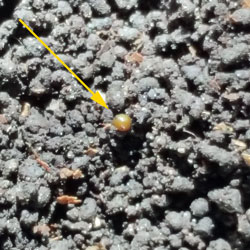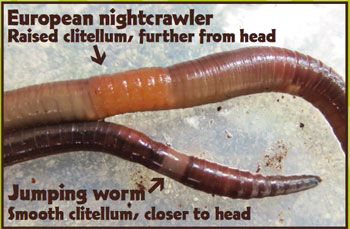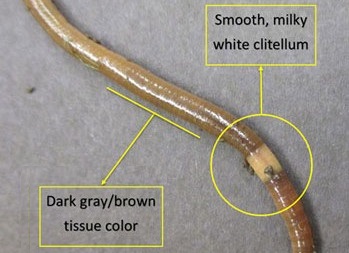DACF Home → Bureaus & Programs → Bureau of Agriculture → Division of Animal and Plant Health → Horticulture → Grower Resources → Amynthas Worms in Maine
Crazy/Jumping/Snake (Amynthas) Worms in Maine
On this page:
- What are Amynthas Worms?
- History in Maine
- Why are Amynthas Worms a problem?
- Amynthas Worm Identification
- What can you do?
What are Amynthas Worms?
Due to our history of glaciation, there are no native earthworms in Maine. Non-native earthworms from Europe (such as nightcrawlers) have become well established here through early colonial trading. Though they are beneficial to our gardens, earthworms can have destructive effects on our forests.
Amynthas worms are a type of earthworm native to East Asia. They are smaller than nightcrawlers, reproduce rapidly, are much more active, and have a more voracious appetite. This rapid life cycle and ability to reproduce asexually gives them a competitive edge over native organisms, and even over nightcrawlers. When disturbed, Amynthas worms jump and thrash about, behaving like a threatened snake.
Amynthas worms are known and sold for bait and composting under a variety of names including snake worms, Alabama jumper, jumping worms, Asian Amynthas worm. They are in the genus Amynthas, and distinguishing between the several species in the genus can be difficult. All species in this genus are considered invasive in Maine. It is illegal to import them into Maine (or to propagate or possess them) without a wildlife importation permit from the Maine Department of Inland Fisheries and Wildlife (MDIFW).
For more information, visit MDIFW's Fish & Wildlife in Captivity webpage.
For further reading and educational materials, check out the Jumping Worms guide from Oregon State.
History in Maine
Amynthas worms are native to Korea and Japan, and are now found in the United States from Maine to South Carolina and west to Wisconsin. Amynthas worms were first collected from a Maine greenhouse in 1899, though an established population of this active and damaging pest was not discovered here until about 2014 when two populations were discovered in Augusta (one at the Viles Arboretum) and two populations were found in Portland. They have also been found in a rhododendron display at the Coastal Maine Botanical Gardens in Boothbay. We believe that Amynthas worms are not yet widespread in Maine, but they have been discovered in some new locations since 2014, including nursery settings. If allowed to spread, Amynthas worms could cause serious damage to horticultural crops and the forest ecosystem in Maine.
Why are Amynthas Worms a Problem?
Amynthas worms change the soil by accelerating the decomposition of leaf litter on the forest floor. They turn good soil into grainy, dry worm castings (aka poop) that cannot support the native understory plants of our forests. Other native plants, fungi, invertebrates, and vertebrates may decline because the forest and its soils can no longer support them. As native species decline, invasive plants may take their place and further exacerbate the loss of species diversity.
In nurseries and greenhouses, Amynthas worms reduce the functionality of soils and planting media and cause severe drought symptoms. After irrigating or rains, you may find these worms under pots. These worms may be inadvertently moved to new areas with nursery stock, or in soil, mulch, or compost.
Many of Maine's forests are already under pressure from invasive insect pests, invasive plants, pathogens, and diseases. Amynthas worms may cause long-term effects on our forests.
Amynthas Worm Identification
- When handled, they act crazy, jump and thrash about, behaving more like a threatened snake than a nightcrawler, Video of jumping worm wriggling
- May shed their tail when handled, Video of jumping worm tail detachment
- Clitellum (the band around their body) is milky white, smooth, and flat to their body
- Often found in groups
- Soil looks very grainy at the surface, like coffee grounds
- Can reproduce by parthenogenisis (asexually), maturing in 60 days, allowing two hatches per season
- Annual species, but tiny cocoons overwinter in the soil
- Best time to find them is late June to mid-October
- In nurseries, they can often be found underneath pots that are sitting on the ground or on landscape fabric
- In forests, they tend to be near the surface, just under accumulations of slash or duff
What can you do?

Amynthas Worm cocoon at yellow arrow, in granular castings, Photo by Marie Johnston, courtesy University of Wisconsin-Madison Arboretum
- Do not buy or use Amynthas worms for composting, vermicomposting, gardening, or bait
- Do not discard live worms in the wild, but rather dispose of them (preferably dead) in the trash
- Check your plantings-know what you are purchasing and look at the soil
- Buy bare root stock when possible
- Be careful when sharing or moving plantings, cocoons may be in the soil
- Photo and information submission form, which works on desktop or mobile. Entries will be submitted to the iMapInvasives Public Database.
- Learn more! Factsheet for Homeowners
- Best Practices for Plant Sale Donors and Buyers in Maine (UMaine Cooperative Extension)
- Plant Sale Recommendations to Reduce Jumping Worm Spread – University of Minnesota Extension (PDF)
- Questions? Contact...
Name Email Phone Gary Fish, State Horticulturist gary.fish@maine.gov 207-287-7545 Hillary Peterson, IPM Entomologist hillary.peterson@maine.gov 207-215-4793

